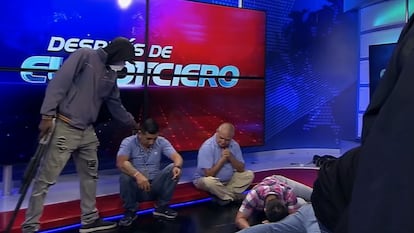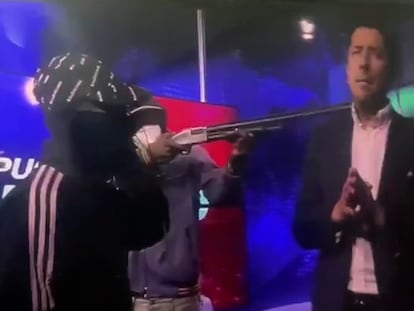TV studio hostages recall terror of on-air attack: ‘It is very easy to kill journalists in Ecuador, too easy’
About 20 hooded men with masks, weapons and dynamite took over the TC Television studio in the middle of the newscast. The journalists talk to EL PAÍS about the trauma of the assault

The last hour of the newscast on Ecuador’s TC Televisión channel had begun. The presenters Jorge Rendón and Vanessa Filella were in the studio when the shots were heard a few meters from the reception of the national TV channel’s building in Guayaquil. The sounds of screams and people being hit came down the hallway towards the studio. It was around 2:15 p.m. on Tuesday.
Before the attack on the TV studio, violence was already sweeping across Ecuador, with bomb attacks, cars set on fire, shootings and murders. In five prisons, 125 prison guards and 15 administrative workers had been kidnapped by inmates. On social media, videos showed some of the hostages being murdered. Meanwhile, the government remained silent. There was a lot to report on.
“When I heard the shots, all of us who were in the newsroom ran to find a place to hide,” says Alina Manrique, editor-in-chief, who ran to a bathroom. “Everyone was looking for a place to hide; the archive, the bathrooms, we went up to other floors.” Two other colleagues hid with her in the bathroom, from where they wrote to ask for help.

“Then we were silent… very silent,” explains Alina. “Then we heard them approaching, and they started banging on the door, insulting us and threatening to kill us, and we had no choice but to leave with our hands up.” The armed men tore Alina’s necklace from her neck. The three were beaten and thrown on the floor of the studio, where the unprecedented attack was being broadcast live on television. About 20 hooded men in masks, carrying weapons and dynamite, took over the TC Television studio in the middle of the newscast.
Ten other hostages were with the editor-in-chief. The terrorists asked for microphones, and the sound engineer followed their orders. Everyone tried to remain calm in the midst of the terror. The young men patrolled the set, dragging and kicking the hostages on the ground, and pointing guns at their heads. They even fired shots into the air. One of the bullets ricocheted off the leg of a cameraman, who remains in hospital due to the injury.
Journalist Stalin Baquerizo ran to another bathroom to hide with a companion. “They shouted, ‘We are the active Tiguerones.’ I heard my colleagues screaming, shots, banging on doors, glass breaking on the floor,” says Baquerizo, describing his panic during the attack. He said he tried to breathe more quietly so they wouldn’t hear him. The kidnappers asked for Baquerizo — one of the most high-profile faces on the news program — and when they were told that he was not there, the criminals, frantic, picked up journalist José Luis Calderón from the floor, placed a stick of dynamite in his jacket pocket and forced him to give a message to the police: do not enter the TV channel headquarters, leave the premises.
Almost 30 minutes passed until helicopters and police shots were heard. The criminals tried to escape by taking some of the hostages and using them as human shields. Alina was one of those who was taken. “There were five of us, and they took us, looking for a way out, until we arrived at another smaller studio, where they made us record videos asking the police not to shoot and to leave.”
When the officers entered, the hostages were standing in the middle. “I was afraid of dying from a shot fired by the police or one of the guys, who were very nervous,” says Alina. In the end, the group handed over their weapons. “I was on my knees and when a police officer helped me get up, I knew I had survived,” says Alina. “Today, it is very easy to kill journalists in Ecuador, too easy.”
Although the channel must remain closed for two days so that the Prosecutor’s Office can carry out its investigations into what happened, some of the workers woke up early Wednesday, like every day, for the morning news broadcasts, among them Jorge García. He is the journalist in charge of covering police reports, who knows the most dangerous areas of Guayaquil, and even amid the high levels of insecurity he has continued to work. If García had arrived a few minutes earlier, he would have been inside the building during the attack. He got there just moments after the criminals entered and was the one who called the police. “My family didn’t want me to leave the house, we are all scared,” he says.
Police have arrested 13 kidnappers, but TC Televisión workers said they counted more of them. Among those arrested are two minors. The oldest was 25 years old. They will be charged with terrorism.
Sign up for our weekly newsletter to get more English-language news coverage from EL PAÍS USA Edition
Tu suscripción se está usando en otro dispositivo
¿Quieres añadir otro usuario a tu suscripción?
Si continúas leyendo en este dispositivo, no se podrá leer en el otro.
FlechaTu suscripción se está usando en otro dispositivo y solo puedes acceder a EL PAÍS desde un dispositivo a la vez.
Si quieres compartir tu cuenta, cambia tu suscripción a la modalidad Premium, así podrás añadir otro usuario. Cada uno accederá con su propia cuenta de email, lo que os permitirá personalizar vuestra experiencia en EL PAÍS.
¿Tienes una suscripción de empresa? Accede aquí para contratar más cuentas.
En el caso de no saber quién está usando tu cuenta, te recomendamos cambiar tu contraseña aquí.
Si decides continuar compartiendo tu cuenta, este mensaje se mostrará en tu dispositivo y en el de la otra persona que está usando tu cuenta de forma indefinida, afectando a tu experiencia de lectura. Puedes consultar aquí los términos y condiciones de la suscripción digital.
More information
Archived In
Últimas noticias
Most viewed
- Sinaloa Cartel war is taking its toll on Los Chapitos
- Oona Chaplin: ‘I told James Cameron that I was living in a treehouse and starting a permaculture project with a friend’
- Reinhard Genzel, Nobel laureate in physics: ‘One-minute videos will never give you the truth’
- Why the price of coffee has skyrocketed: from Brazilian plantations to specialty coffee houses
- Silver prices are going crazy: This is what’s fueling the rally










































